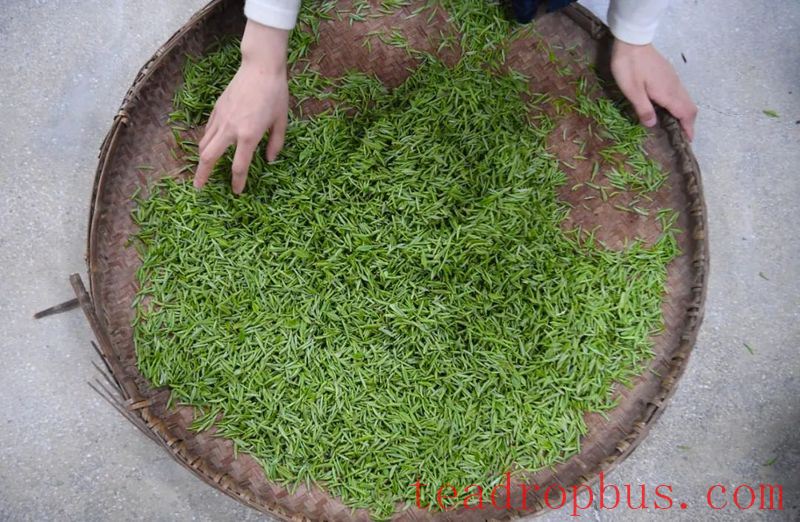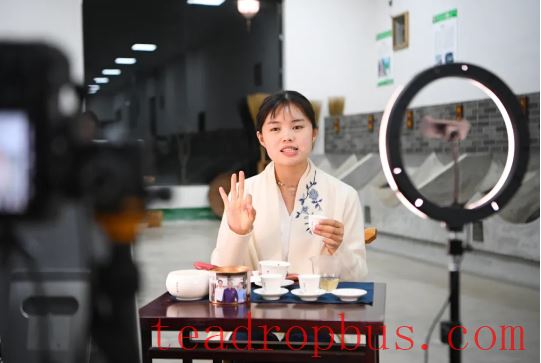As the main and core production area of China's top ten famous teas, “Xinyang Maojian,” in recent years, the Shilihedistrict of Xinyang City, Henan Province, has adhered to the coordinated development of Tea culture, tea industry, and tea technology (“three teas”). It has successively been awarded more than 30 national honors, including one of China's Top Ten Ecological Tea-producing Counties and a Pioneer County for the Coordinated Development of the “Three Teas.” Currently, the district has a tea garden area of 635,000 mu, with a tea output of 57,000 tons and a comprehensive value-added revenue from the tea industry reaching 11.7 billion yuan. From a single leaf to a product and then to a brand, today, the tea industry has become a crucial breakthrough point for the district to promote rural revitalization.
 In March, in Tumen Village, Shilihedistrict, Xinyang City, Henan Province, tea industry professionals are sorting fresh tea leaves. Photo by Hao Yuan/Xinhua News Agency
In March, in Tumen Village, Shilihedistrict, Xinyang City, Henan Province, tea industry professionals are sorting fresh tea leaves. Photo by Hao Yuan/Xinhua News Agency
Industry as the Foundation
Strengthening Hard Power for Development
Focusing on “three products and one standard,” it provides solid support for “Xinyang Maojian” to enter a new phase of standardized and specialized development, and treats project construction as a powerful engine for high-quality development in the tea industry, focusing on all aspects of project construction.
Grasping the “three products and one standard.” In terms of variety improvement, it is accelerating the construction of a germplasm resource nursery for the “Xinyang No. 10” tea tree, strengthening protection, cultivation, and inheritance of varieties, and continuously improving the quality of tea leaves from the source. In the past three years, a total of 15 million yuan has been invested in cultivation and promotion, building one standardized superior seedling breeding base, and the coverage rate of the “Xinyang No. 10” superior variety in the district has exceeded 20%. For quality enhancement, the “Shilihedistrict Cloud Appreciation Maojian” blockchain traceability system has successfully gone online, giving every leaf in the 25,000 mu of tea gardens on the eight famous mountains its own unique “ID card.” Promoting the construction of ecological and organic tea gardens, the eight famous mountains have achieved unified prevention and control, and a total of 250,000 mu of ecological tea gardens have been built in the district, accounting for over 40% of the total tea garden area, with more than 95% of the tea gardens meeting green ecological standards. For brand building, it is fully promoting the construction of the “Xinyang Maojian 521” high-end green tea brand, supporting influential local tea companies to create independent brands. Through shooting advertisements, making songs, and other methods, the regional public brand of Xinyang Maojian is being promoted on media platforms such as CCTV and Xuexi Qiangguo. In terms of standardized production, traditional tea companies are encouraged to update their tea-picking and tea-making equipment. The first intelligent production line for Xinyang Maojian in the city has started operation, achieving “one decrease and one increase” in production costs and product standards, marking the transition from making tea based on experience to making tea based on data.

After graduating from university in 2025, Xiao Junjing, a girl born after 1995 from Tumen Village, Shilihedistrict, returned to her hometown to begin studying tea production. To make more people understand Xinyang Maojian, Xiao Junjing combined local customs with a series of short videos, popularizing tea benefits and promoting tea culture. She currently has over 20,000 followers on short video platforms. This image shows Xiao Junjing promoting tea culture via live streaming on an internet platform. Photo by Hao Yuan/Xinhua News Agency
Promoting project construction. Closely integrating the development of the tea industry with the construction of a national modern agricultural industrial park, a national agricultural modernization demonstration zone, and a provincial rural revitalization demonstration zone, the district is organizing a project library for the tea industry around areas such as facility construction, improvement of the industrial chain and supply chain, construction of innovation platforms, and digital tea gardens, planning and reserving 65 key projects in total. At the same time, it has established a joint meeting mechanism for key tea industry projects to ensure that projects can be introduced and implemented. Since 2025, the Shilihedistrict has successfully signed strategic framework cooperation agreements with eight companies, including the China Tea Company, and established friendly contacts with tea companies in Japan's Shizuoka Prefecture, prioritizing the introduction of the Bangli summer and Autumn Tea production and processing project.
Achieving interlinkage of mechanisms. Establishing interest linkage mechanisms such as “platform company + operating company + village collective + villagers” and “leading enterprise + medium and small tea companies + cooperatives + villagers,” promoting tea garden entrustment management; establishing a win-win mechanism of “manager + tea farmers + villagers,” revitalizing rural resources and assets, and achieving group development through entrusted management and unified operations; establishing a collaborative cooperation mechanism between state-owned companies and specialized enterprises, planning and implementing a batch of projects such as the upgrading and transformation of tea garden roads, effectively solving bottlenecks in funding, operations, and maintenance faced by the industry's development.
Enhancing financing support. Promoting a green financial system, pushing for leveraged financial assistance, expanding inclusive finance with government subsidies and bank support, innovating financial assistance policies such as “Tea Country Quick Loans” and “Beneficial Tea Loans,” and cumulatively issuing loans totaling 1.339 billion yuan to 7,176 households, effectively addressing the problems of lack of funds for project initiation and difficulty in obtaining financing for expansion faced by tea farmers and small and micro tea companies.
Integration as the Key
Improving Competitiveness in Development
Consolidating and expanding the advantages of the Shilihedistrict as a national demonstration area for all-region tourism, it persists in the integrated development of tea, culture, and tourism, transforming the tea countryside of Shilihedistrict into a poetic and distant place people yearn for. In 2025, the Shilihedistrict achieved comprehensive income of 5.01 billion yuan from tea, culture, and tourism.
Enriching the connotations of tea, culture, and tourism. Fully exploring related historical and folk cultures such as tea history, tea songs, tea arts, and tea people, integrating Shilihedistrict tea culture into Chinese tea culture and world tea culture, enhancing cultural taste and realm. At the same time, enriching and expanding emerging tea culture, cultivating new consumer groups through activities such as tea brewing gatherings, tea-making competitions, and tea culture studies. Currently, 46 distinctive rural tourism spots have been built in the district, with 70% of the income of residents in the rural revitalization demonstration zone coming from the tea, culture, and tourism industry.
Expanding the carriers of tea, culture, and tourism. Building a ring road. The entire South Bay Lake road has undergone a comprehensive upgrade, and the 44.6-kilometer-long most beautiful ring lake tea source greenway has now been fully constructed, organically connecting four scenic areas, seven agritainment complexes, eight tea pavilions, 16 “one bridge, one scene” sites, and 35 landscape nodes along the route. Tourist and cultural projects such as South Bay Lake, Wenxin Tea Village, and Hejiadian Camping Base, as well as model villages for rural tourism like Haojiachong Village, are strung together like pearls, driving rapid development of the tea, culture, and tourism industry. Beautifying tea gardens. Focusing on good mountains, good water, and good tea, 36 tea-themed homestays, 33 camping bases, and 28 tea estates have been built, providing employment for nearly 10,000 farmers, with an average income increase of 32,000 yuan per household. The effect of enriching the people and strengthening the district through tea, culture, and tourism has become even more prominent. Using urban areas to radiate to rural areas, mass teahouses and shared tea spaces are rationally laid out, achieving connectivity, linking, and expansion, basically constructing a tea space layout covering the entire region, all seasons, all industries, and all age groups. Using a set of platforms. Util